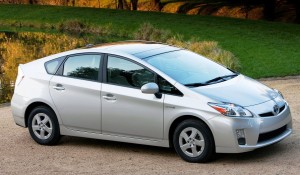
Rising prices, reduced incentives -- and shortages -- of popular Japanese products like the Prius had a harsh impact on May car sales.
It’s been a good year for the U.S. auto industry – or at least it was until last month, most manufacturers expected to report a slump in sales when they report May numbers this week.
Industry analysts blame a variety of factors for the downturn – which occurred during the month that normally marks the start of the annual spring buying season – notably including a shortage of Japanese-made products, the result of the March 11 natural disaster that devastated that country’s auto industry.
In turn, makers have responded by trimming back rebates and other sales incentives – and when you add in the price hikes many manufacturers have taken in recent months, many potential buyers have decided to wait and see if better deals could follow later in the year, according to industry analysts.
“Overall automaker incentives (in May were) at the lowest levels we’ve seen in years,” said Jessica Caldwell, director of industry analysis at Edmunds.com. “These low incentives are making it increasingly difficult for consumers to find good deals.”
That’s especially true on the small cars and hybrids that have seen a surge in demand due to the ongoing run-up in fuel prices, though Caldwell also noted “We’re seeing better offers on large vehicles that have taken a hit in demand.”
Overall, industry analysts are expecting new car, crossover and light truck sales totaled just 1.1 million last month, down from 8% from April and off 4% from May 2010. For the first time this year, that will translate into a seasonally-adjusted annual sales rate, or SAAR, of less than 13 million, and could dip as low as 11.5 million, according to Jeff Schuster, head of global forecasting for J.D. Power and Associates.
Excluding fleet sales, the annualized rate could dip as low as 9.5 million, said Schuster, who cautioned that, “May’s overall performance will hinge on how strong Memorial Day weekend sales were.”
The May numbers will likely vary widely from brand to brand, according to the car pricing site TrueCar.com. It forecasts a sizable 33% dip for Toyota, and 21% for Honda. That reflects the increasingly serious shortages those two makers are currently facing.
The entire Japanese auto industry was shuttered for nearly a month after the northeastern region of that country was hammered by a devastating earthquake and tsunami on March 11. Home market production is still running well below normal while overseas operations have also been slammed. Toyota’s entire U.S. assembly plant network is down this week, and production of a number of key models will continue to be impacted for months to come.
Honda has also felt the brunt of the parts shortage and announced last week that it will take until “sometime in the fall” before production of its new 2012 Civic model will be up to full speed. That’s a serious setback considering the Civic is not only one of Honda’s best-sellers, but one of the most popular products in the U.S. overall.
On the other hand, that’s good news for the company’s Korean and American competitors.
“We have the right products this time” to take advantage of both the Japanese shortages and the rise in fuel prices, said Derrick Kuzak, Ford’s global product development chief.
Hyundai is also taking advantage of the situation with new models like the midsize Sonata Hybrid and the smaller, all-new Elantra. Hyundai and its sibling Korean brand Kia are expected to post 43% sales gains for May, according to TrueCar.com.
An uncertain economy is also taking some of the blame for May’s anticipated weak numbers. Many potential new car buyers have been trying to save money by shifting to the “previously-owned” market, but that has, in turn, driven used car prices up to record levels.
If things don’t improve, analysts suggest, new car buyers could be rewarded with new incentives – especially as Japanese makers begin to get their plants back in operation. After slashing givebacks, Toyota started boosting incentives again in May and could push even higher this coming month. Before the Memorial Day break its North American plants were operating at barely a third of their capacity. That’s supposed to climb to 70% once the lines begin rolling again next week.
